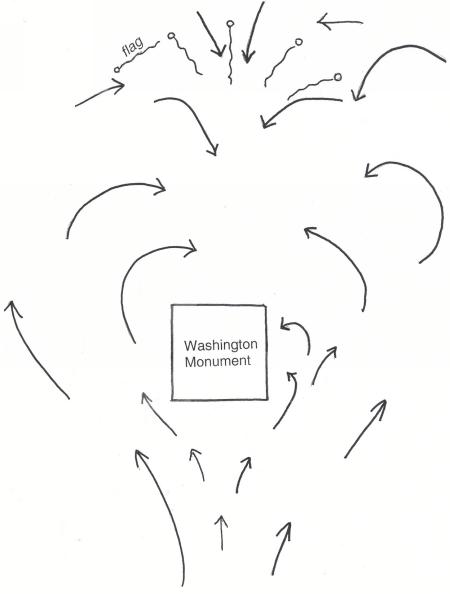GLOBE has protocols for measuring temperature, relative humidity, air pressure, and even aerosols. Did you ever wonder why there isn’t a protocol to measure wind? This picture can give you a hint. The flags in the picture are some of the flags that form a circle around the Washington Monument, in Washington D.C.

Flags on the lee side of the Washington Monument, in Washington, D.C. The flags are wonderful indicators of the varying wind.
We are watching the flags downwind of the Monument. You notice how the flags are all different? This is because the wind, blocked by the Monument, forms eddies on the downwind side. So, even though the wind is over 45 kilometers per hour out of the northwest, the flag in the middle shows that the wind is blowing almost as strongly from the opposite direction! And the flag just to the right of the middle one shows that the wind affecting it is rather slow. Finally, the flags on the left and right side of the picture are being blown southeastward — that is, they show a northwest wind. I include a sketch — with some flags — on how the flags show which way the wind is blowing.

Arrows showing how the wind blows around the Washington Monument. The little circles (poles) with squiggly lines (flags) show how the wind blows the flags. Only a few flags are shown. Imagine how the flags would be blowing in other places.
If we had a film of the flags, we would see them changing rapidly because the wind is changing rapidly. So the little arrows on the sketch are just at an instant in time. But, on average, the wind downwind (or on the lee side) of the Washington Monument would be slower than the wind on its upwind side. In a similar way, the house or apartment you live in or your school building blocks the wind. If the wind is out of the south, and you are on the south side of any of these buildings, the wind would be stronger than if you are on the north side. And, you would see lighter winds for a longer distance than you might think! Once, with a group of 4th-6th-grade students, I walked around their school building with a portable anemometer to measure the wind speed. Not only did the wind speed change a lot, but we could see that the trees and building were blocking the wind.
If you are interested in guessing the wind speed, a good way is to observe smoke, trees, blowing paper, or anything else the wind changes. For example, smoke going straight up means calm winds; and you can feel the wind on your face at 4-7 miles per hour (6-11 kilometers per hour). If you want to learn more about how to estimate wind speeds, find out about the Beaufort Scale for Land, at the web site: www.zetnet.co.uk/sigs/weather/Met_Codes/beaufort.htm. I used this scale when I took weather observations as a child.
So — keep your eyes open for flags, streamers, and wind socks — and watch the trees — to observe the wind in your area!

Muy interesante la relación que se hace entre el viento, las banderas y los edificios. En nuestro colegio trabajamos con el protocolo de atmósfera y tenemos dos banderas que utilizamos para observar la orientación del viento como un método de observación directa.
Marta Gebhardt
Colegio de Todos los Santos
Buenos Aires
Argentina
Que bueno que ustedes estan trabajando con el protocolo de atmosphera! Utilizando las bandaras para obsevar la orientacion del viento es un metodo buenisimo. Las banderas les dan a ustedes la misma orientacion del viento?
(So good that you are working with the atmosphere protocol! Using the flags to observe the direction of the wind is a good method. Do the flags give you the same wind direction?)
You know that was a great idea you have because I didn’t think about it before, and it is that the flags will blow the same way that the wind blows.
So thanks for giving us a way to know what way the wind is blowing.
And another way is to feel which way the wind tries to push you
This is true. We sometimes have very strong winds in Boulder. The strongest winds I remember were about 150 miles per hour (about 240 kilometers per hour or 67 meters per second).
I don’t think I was outside for those winds, but I was for winds of the order of 100 miles per hour (160 km/hour), and the wind really did push you! The other way you could tell the wind direction was watching pieces of paper, wood, and other things flying by. One hopes that they go by without hitting you!
This article is very interesting and exciting